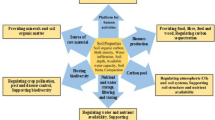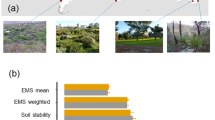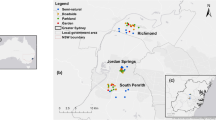Abstract
Aims
Urban soils are the basis of many ecosystem services in cities. Here, we examine formerly residential vacant lot soils in Cleveland, Ohio and Detroit, Michigan, USA for their potential to provide multiple ecosystem services. We examine two key contrasts: 1) differences between cities and 2) differences within vacant lots created during demolition, specifically pre-existing (i.e., prior to demolition) soils outside of the building footprint and fill soils added within the former building’s footprint.
Methods
Deep soil cores were collected from vacant lots in Cleveland and Detroit. Soil properties that are proxies for three ecosystem services were measured: hydraulic conductivity for stormwater retention, topsoil depth and soil nitrogen (N) level for support for plant growth, and soil carbon (C) content for C storage.
Results
Both city and soil group contrasts created distinct ecosystem service provisioning based on proxy measures. Cleveland soils had greater hydraulic conductivity and greater soil C and N levels but thinner topsoil layers than Detroit. Within vacant lots of both cities, pre-existing soils had greater soil C and N levels, but lower hydraulic conductivity values than fill soils.
Conclusions
Soil properties of vacant lots were generally suitable for providing multiple ecosystem services. City-level differences in soil properties created differences in ecosystem service potential between cities and these differences were evident in pre-existing and fill soils. When comparing between cities, though, fill soils were more similar than pre-existing soils indicating some homogenization of ecosystem service potential with greater redistribution of soil.



Similar content being viewed by others
References
Amoozegar A (1989) Comparison of the Glover solution with the simultaneous-equations approach for measuring hydraulic conductivity. Soil Sci Soc Am J 53:1362–1367
Andrews SS, Karlen DL, Mitchell JP (2002) A comparison of soil quality indexing methods for vegetable production systems in Northern California. Agric Ecosyst Environ 90:25–45. doi:10.1016/S0167-8809(01)00174-8
Beard JB (1973) Turfgrass: Science and Culture. Prentice-Hall, Englewood Cliffs, NJ, US
Berland A, Schwarz K, Herrmann DL, Hopton ME (2015) How environmental justice patterns are shaped by place: terrain and tree canopy in Cincinnati, Ohio, USA. Cities Environ 8(1):Article 1
Bowen CK, Schuman GE, Olson RA, Ingram J (2005) Influence of topsoil depth on plant and soil attributes of 24-year old reclaimed mined lands. Arid L Res Manag 19:267–284
Bowman AO, Pagano MA (2004) Terra Incognito: Vacant Land and Urban Strategies. Georgetown University Press, Washington DC
Detroit Future City (2012) 2012 Detroit Strategic Framework Plan. Inland Press, Detroit, MI
City of Detroit (2014) Detroit Blight Removal Task Force Plan. Detroit, MI
Craul PJ (1992) Urban Soil in Landscape Design. John Wiley and Sons, New York
Craul PJ (1999) Urban Soils: Applications and Practices. John Wiley and Sons, New York, NY
Dunne T, Leopold LB (1978) Water in Environmental Planning. W.H. Freeman Co., San Francisco
Effland WR, Pouyat RV (1997) The genesis, classification, and mapping of soils in urban areas. Urban Ecosyst 1:217–228
Furio B, Grosshans J, Bratko J, et al (2013) On the road to reuse: residential demolition bid specification development tool. US Environmental Protection Agency Report 560K13002. US EPA Region 5, Chicago, IL, USA
Gee GW, Or D (2002) Particle size analysis. In: Dane JH, Topp GC (eds) Methods of Soil Analysis. American Society of Agronomy, Madison, WI, USA, pp. 255–289
Golubiewski NE (2006) Urbanization increases grassland carbon pools: effects of landscaping in Colorado’s Front Range. Ecol Appl 16:555–571
Green OO, Garmestani AS, Albro S, et al. (2016) Adaptive governance to promote ecosystem services in urban green spaces. Urban Ecosytems 19:77–93. doi:10.1007/s11252-015-0476-2
Groffman PM, Cavender-Bares J, Bettez ND, et al. (2014) Ecological homogenization of urban USA. Front Ecol Environ 12:74–81. doi:10.1890/120374
Haase D (2008) Urban ecology of shrinking cities: an unrecognized opportunity? Nat Cult 3:1–8. doi:10.3167/nc.2008.030101
Haase A, Rink D, Grossmann K, et al. (2014a) Conceptualizing urban shrinkage. Environ Plan A 46:1519–1534. doi:10.1068/a46269
Haase D, Haase A, Rink D (2014b) Conceptualizing the nexus between urban shrinkage and ecosystem services. Landsc Urban Plan 132:159–169
Herrmann DL, Pearse IS, Baty JH (2012) Drivers of specialist herbivore diversity across 10 cities. Landsc Urban Plan 108:123–130. doi:10.1016/j.landurbplan.2012.08.007
Hopkins KG, Morse NB, Bain DJ, et al. (2015) Assessment of regional variation in streamflow responses to urbanization and the persistence of physiography. Environ Sci Technol. doi:10.1021/es505389y
Huyler A, Chappelka AH, Prior SA, Somers GL (2014) Drivers of soil carbon in residential “pure lawns” in Auburn, Alabama. Urban Ecosyst 17:205–219. doi:10.1007/s11252-013-0294-3
Jenny H (1941) Factors of Soil Formation: A System of Quantitative Pedology. McGraw-Hill, New York
Kremer P, Hamstead ZA (2015) Transformation of urban vacant lots for the common good: an introduction to the special issue. Cities Environ 8(2):Article 1
Martinez-Fernandez C, Audirac I, Fol S, Cunningham-Sabot E (2012) Shrinking cities: urban challenges of globalization. Int J Urban Reg Res 36:213–225. doi:10.1111/j.1468-2427.2011.01092.x
McKinney ML (2006) Urbanization as a major cause of biotic homogenization. Biol Conserv 127:247–260. doi:10.1016/j.biocon.2005.09.005
NRCS (2013) Pedon descriptions. in: National Soil Survey Handbook. USDA-Natural Resources Conservation Service, Washington DC, p. 627.08
Oksanen J, Blanchet FG, Kindt R, et al (2015) Vegan: community ecology package
Pataki DE, Carreiro MM, Cherrier J, et al. (2011) Coupling biogeochemical cycles in urban environments: ecosystem services, green solutions, and misconceptions. Front Ecol Environ 9:27–36. doi:10.1890/090220
Pavao-Zuckerman MA (2008) The nature of urban soils and their role in ecological restoration in cities. Restor Ecol 16:642–649
Pavao-Zuckerman MA (2012) Urbanization, soils, and ecosystem services. In: Wall DH, Bardgett RD, Behan-Pelletier V, et al. (eds) Soil Ecology and Ecosystem Services. Oxford University Press, Oxford, pp. 270–281
Pavao-Zuckerman MA, Byrne LB (2009) Scratching the surface and digging deeper: exploring ecological theories in urban soils. Urban Ecosyst 12:9–20
Pickett STA, Cadenasso ML (2009) Altered resources, disturbance, and heterogeneity: a framework for comparing urban and non-urban soils. Urban Ecosyst 12:23–44
Pouyat R, Groffman P, Yesilonis I, Hernandez L (2002) Soil carbon pools and fluxes in urban ecosystems. Environ Pollut 116:S107–S118
Pouyat RV, Pataki DE, Belt KT, et al. (2007) Effects of urban land-use change on biogeochemical cycles. In: Terrestrial Ecosystems in a Changing World. Springer, Berlin Heidelberg, pp. 45–58
Pouyat RV, Yesilonis ID, Golubiewski NE (2009) A comparison of soil organic carbon stocks between residential turf grass and native soil. Urban Ecosyst 12:45–62. doi:10.1007/s11252-008-0059-6
Pouyat RV, Szlavecz K, Yesilonis ID, et al. (2010) Chemical, physical, and biological characteristics of urban soils. In: Aitkenhead-Peterson J, Volder A (eds) Urban Ecosystem Ecology. Agronomy M. American Society of Agronomy, Crop Science Society of America, Soil Science Society of America, Madison, WI, USA, pp. 119–152
R Core Team (2014) R: A language and environment for statistical computing. R Foundation for Statistical Computing, Vienna, Austria
Raciti SM, Groffman PM, Jenkins JC, et al. (2011a) Nitrate production and availability in residential soils. Ecol Appl 21:2357–2366
Raciti SM, Groffman PM, Jenkins JC, et al. (2011b) Accumulation of carbon and nitrogen in residential soils with different land-use histories. Ecosystems 14:287–297. doi:10.1007/s10021-010-9409-3
Rhea L, Shuster W, Shaffer J, Losco R (2014) Data proxies for assessment of urban soil suitability to support green infrastructure. J Soil Water Conserv 69:254–265. doi:10.2489/jswc.69.3.254
Schilling J, Logan J (2008) Greening the Rust Belt. J Am Plan Assoc 74:451–466
Schwarz K, Cutts BB, London JK, Cadenasso ML (2016) Growing gardens in shrinking cities: a solution to the soil lead problem? Sustainability 8:141
Shuster WD, Dadio S, Drohan P, et al. (2014a) Residential demolition and its impact on vacant lot hydrology: implications for the management of stormwater and sewer system overflows. Landsc Urban Plan 125:48–56. doi:10.1016/j.landurbplan.2014.02.003
Shuster WD, Dadio SD, Burkman CE, et al. (2014b) Hydropedological assessments of parcel-level infiltration in an arid urban ecosystem. Soil Sci Soc Am J. doi:10.2136/sssaj2014.05.0200
Soil Survey Staff (1993) Soil Survey Manual, Handbook 1. USDA-Soil Conservation Service, Washington DC
Soil Survey Staff (2010) Keys to soil taxonomy, 11th edn. USDA-Natural Resources Conservation Service, Washington DC
Walsh CJ, Fletcher TD, Burns MJ (2012) Urban stormwater runoff: a new class of environmental flow problem. PLoS one 7:e45814
Wickham H (2009) ggplot2: elegant graphics for data analysis. Springer, New York
Acknowledgments
We thank A. Knerl and K. Gilkey for research assistance. Previous versions of this paper were greatly improved by the comments of three anonymous reviewers. Partial financial support was provided by an appointment of D.L. Herrmann to the research participation program with the Oak Ridge Institute for Science and Education through the US DOE and US EPA. The views expressed in this paper are those of the authors and do not represent the views or policies of the U.S. Environmental Protection Agency.
Author information
Authors and Affiliations
Corresponding author
Ethics declarations
Conflict of interest
The authors declare that they have no conflicts of interest.
Additional information
Responsible Editor: Stephen John Livesley.
Rights and permissions
About this article
Cite this article
Herrmann, D.L., Shuster, W.D. & Garmestani, A.S. Vacant urban lot soils and their potential to support ecosystem services. Plant Soil 413, 45–57 (2017). https://doi.org/10.1007/s11104-016-2874-5
Received:
Accepted:
Published:
Issue Date:
DOI: https://doi.org/10.1007/s11104-016-2874-5




